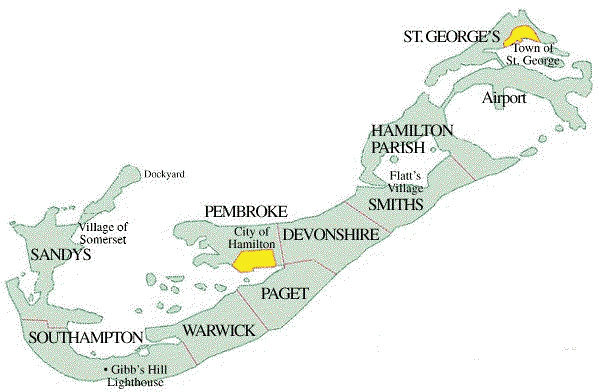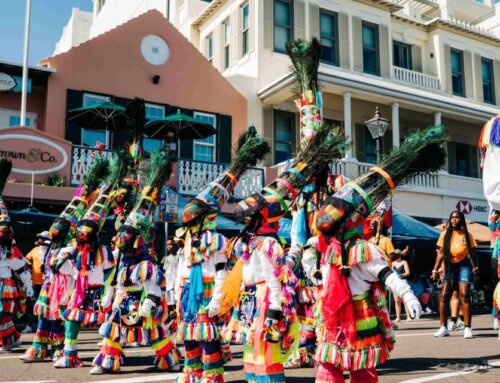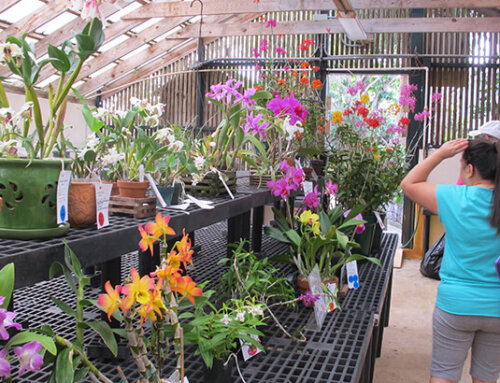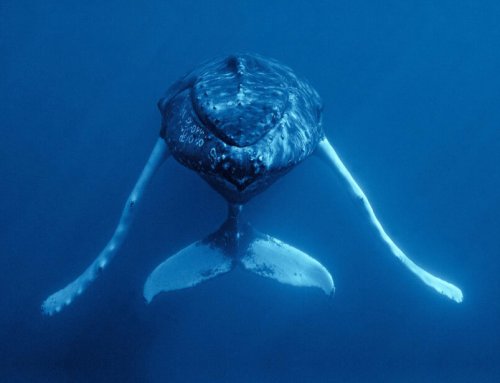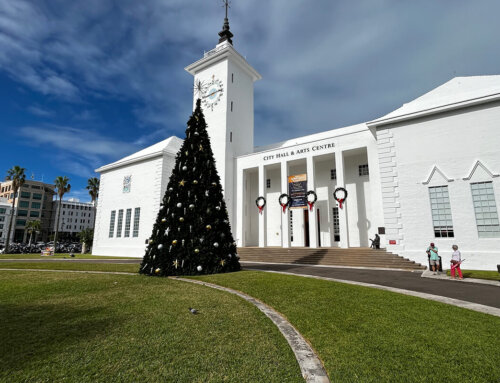Bermuda’s Parishes and municipalities
The nine geographical counties, city, town and villages of these Atlantic Islands
City of Hamilton
The only city and bigger of the two municipalities. In Pembroke Parish. Bermuda’s capital and a port city, it is named after Henry Hamilton. He was British Lieutenant Governor and then Governor here from 1788 to 1794. Born in Dublin, Ireland, in 1734, as the fourth of seven children, he was of Scottish blood and could trace his ancestry through Scottish nobility even to Mary Queen of Scots. His great grandfather was Sir Frederick Hamilton, Baron Paisley and Governor of Ulster, a position which necessitated a change of residence from Scotland to Ireland for the family and resulted in Henry’s birth a century later. Henry’s grandfather, Gustavus Hamilton, had a distinguished military career, was raised to the King’s Privy Council and became Viscount Boyne in the Irish peerage.
Devonshire Parish
It was named for Bermuda’s Elizabethan patron, William Cavendish, First Earl of Devonshire (1552-1626). He took his title from the southern English maritime county (Devon, not Devonshire).
William Cavendish was the uncle of the Earl of Pembroke. He was born to an enormous fortune. He entered Parliament as the member for Newport in the year of the Armada and remained inconspicuous until the death of Queen Elizabeth 1 and accession of King James.
He was given a barony by the King and in 1618 bought his Earldom for a further 10,000 pounds. He was a member of the Council of the Virginia Company of 1612 – which included Bermuda – and Bermuda Company of 1615.
He was a gentlemen Adventurer who invested to colonize Bermuda and largest shareholder in the original Cavendish Tribe (Devonshire Parish) in 1619. But he died almost unnoticed in 1626.
Hamilton Parish
It was not the original name. It was Harrington Tribe, after Lucy Harrington, a wealthy and influential woman in the Elizabethan era.
Part of the Parish and a local Government run school still have her name.
Then came another Elizabethan patron, James Hamilton, 2nd Marquis of Hamilton (1589 to 1625). He was one of the many Scots peers who accompanied King James VI of Scotland and first of England to London when he ascended the throne on the death of Queen Elizabeth 1 in 1603.
Loyal Hamilton was once proposed as a husband for the King’s daughter. In 1620, he became a member of the Council for the Plantations of New England and later was rewarded as a Knight of the Garter.
He died of a malignant fever in 1625 and his death is said to have hastened that of his Royal friend.
Paget Parish
It is on Bermuda’s South, Middle and Harbor Roads. It was named after Elizabethan patron and English aristocrat William Paget, fourth Lord Paget (1572-1629). Born in the year of the Massacre of St. Bartholomew, he spent much of his life under suspicion in England because of his father’s ardent Roman Catholicism.
His father fled to Spain and was considered a traitor. His son turned Protestant and grew to hate all things Spanish but was still mistrusted by Queen Elizabeth, even after serving with Lord Essex in the Calais Expedition of 1596. He avoided the same fate as Essex. He was finally restored to his paternal lands and honors by King James in 1605. In 1612 he became a member of the Virginia Company which then included Bermuda.
He was one of the illustrious band of gentlemen “Adventurers” who invested in the Bermuda Company to colonize the Bermuda islands from 1615 onwards. He was the largest shareholder in the original Paget Tribe named after him in 1617, later Paget Parish. He is buried at West Drayton in Middlesex, England.
Pembroke Parish
It has North Shore and Hamilton Harbor sea frontage. It was named after Bermuda’s Elizabethan patron, English aristocrat the third Earl of Pembroke (1580-1630). Pembroke was the nephew of Sir Philip Sydney and richest peer in England. He took his title from the market town of Pembroke in Pembrokeshire, Wales. (This is how the Bermuda Parish got its name). He was the patron of artists like John Dunne, Inigo Jones and Ben Jonson.
Dramatist William Shakespeare knew him well and dedicated his first folio printing of his collected works to Pembroke and his brother. The Earl was banished from the Court of Queen Elizabeth when she heard he had romantic interests elsewhere.
Brought back into favor by King James, he was made a Knight of the Garter within a year. He joined the Council of the Virginia Company in 1609 and the Bermuda Company in 1615. As one of its illustrious band of gentlemen “Adventurers” he was the largest shareholder in the original Pembroke Tribe, later Pembroke Parish. Weak in health and melancholy, he died of an apoplexy brought on by a full and cheerful supper.
Sandys Parish
It includes Somerset Island (named after the English county of Somerset, like Somerset in New Jersey 08873, USA and other much younger places with Somerset in their name). It also includes Boaz Island, Ireland Island and Watford Island connected by bridges and serviced by buses and ferries.
It was named in honor of one of Bermuda’s Elizabethan patrons, English aristocrat Sir Edwin Sandys (1561-1629). He was the second son of the Archbishop of the city of York in England.
He was a Member of Parliament for Andover in 1586 and accompanied King James on his triumphal progress through England when he ascended the throne on the death of Queen Elizabeth.
Sandys was knighted the same year but his royal favor was withdrawn when it was noted he had nonconformist sympathies. He was a member of the Council for Virginia in 1607 and was personally responsible for the emigration of many families.
He was also suspected of encouraging republicanism in those places. He joined the Bermuda Company in 1615 as one of the Gentlemen Adventurers who invested to colonize Bermuda.
Smith’s Parish
On Main Island. It lies between Devonshire Parish to the west and Hamilton Parish to the East. It has sea frontage on the South and North shores and southern side of the inland lake of Harrington Sound.
The Parish was named after one of Bermuda’s Elizabethan patrons, Sir Thomas Smith or Smythe (1588-1625) an English aristocrat with humble beginnings as a London haberdasher’s assistant who raised himself by his integrity to great responsibilities and riches.
He was knighted by King James and became the first Governor of the famous East India Company and first Governor of the Somers Isles Company – Bermuda – an office he held at the time of his death in 1625. Because he supported British efforts to discover a Northwest Passage to the Orient, his name was given by explorer William Baffin to Smith’s Sound on the Canadian coast of British Columbia.
Also named after this empire builder is Smith’s Island, 61 acres, in St. George’s Harbor, St. George’s Parish, Bermuda’s first settlement.
Southampton Parish
It was named after Henry Wriothesley, Third Earl of Southampton (1573-1624), an English aristocrat, one of the most colorful Elizabethans, the patron and friend of William Shakespeare.
He served against the Spaniards in the Calais Expedition of 1596 but in 1599 was implicated in the Essex Plot and imprisoned by Queen Elizabeth 1. Set free by King James, he was made a Knight of the Garter.
He died in the Low Countries where he had gone as a volunteer once more to fight the tyranny of Spain.
Always interested in overseas exploration, he was a member of the Council of the Virginia Company in 1605, the North West Company of 1612.
He was one of the gentlemen Adventurers who invested in the newly formed Bermuda Company of 1615. He was the largest shareholder in the original Southampton Tribe.
St. George’s Parish
Includes Town of St. George. The Parish was named jointly for Bermuda’s Elizabethan patron and founder, Englishman Admiral Sir George Somers and the patron saint of England.
It is all of St. George’s Island (originally Tortus Island) and partly Main Island, Bermuda’s biggest island and historically significant. St. George’s Island is 703 acres. It was the first to be colonized.
It includes St. George’s Harbor, all of St. David’s Island, originally 503 acres but enlarged in 1942 to build the (now decommissioned) United States Naval Air Station.
The Parish starts where Hamilton Parish ends, on the road after Blue Hole Hill, before the Causeway to the airport.
It is joined to Main via a road and to St. George’s Island via the Swing Bridge, then over it and Longbird bridges briefly into Hamilton Parish then this Parish again at Tucker’s Town and Castle Islands. The Parish also includes all islands in Castle and St. George’s Harbors.
Town of St.George In St. George’s Parish
The fifth oldest English-speaking municipality in the Western Hemisphere, after St. John’s in Newfoundland founded by the British, Annapolis Royal (formerly Port Royal) founded by the French in Nova Scotia, Canada, in 1605; Jamestown, Virginia, founded by the British in 1607; and Montreal in 1608.
Warwick Parish
Named after one of Bermuda’s Elizabethan patrons, Robert Rich, second Earl of Warwick (1587-1658). He was the largest original shareholder in Warwick Tribe, later Parish. This association with the central English county and town of Warwick is overlooked by visitors unless they are from Warwickshire in England or Warwick in Rhode Island, USA. It is why the Earls of Warwick were so titled.
When young, this Earl of Warwick was decorative. Later, he took such an interest in overseas expansion that he became a member of the Bermuda Company in 1614 and was on the Council of the New England Company in 1620. The earl sent privateers to the East Indies.
In 1628 he sailed with other privateers to interrupt Spanish trade with the west. After the accession of King Charles, he became a puritan and joined the Parliamentary opposition. His condemnation of illegal taxation led to his imprisonment.
In the Civil War he was a Captain General of the Parliament’s Armies and was responsible for the Royal Navy declaring against the King.
A friend of Oliver Cromwell, he died in 1658 mourned by the Lord Protector.

